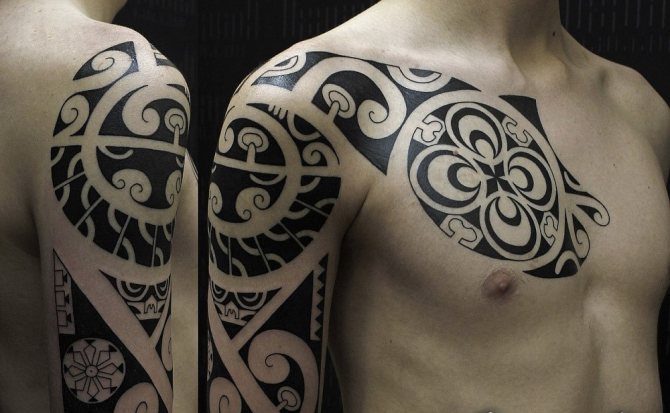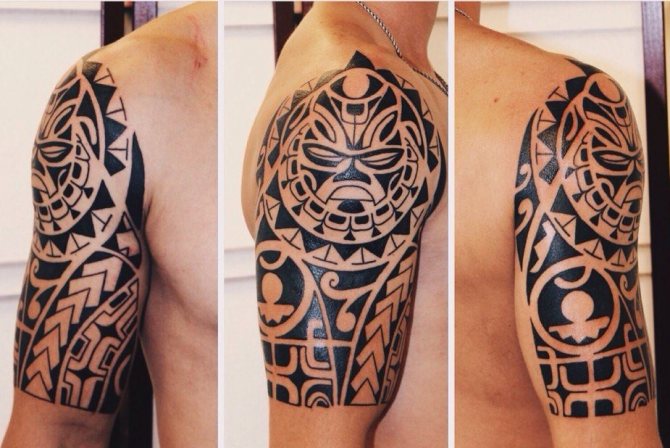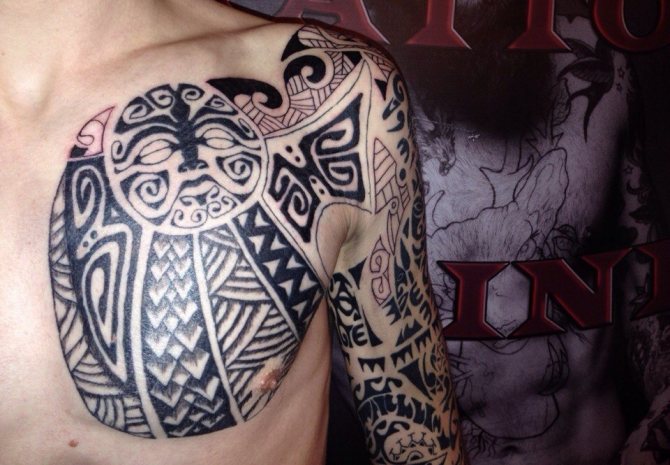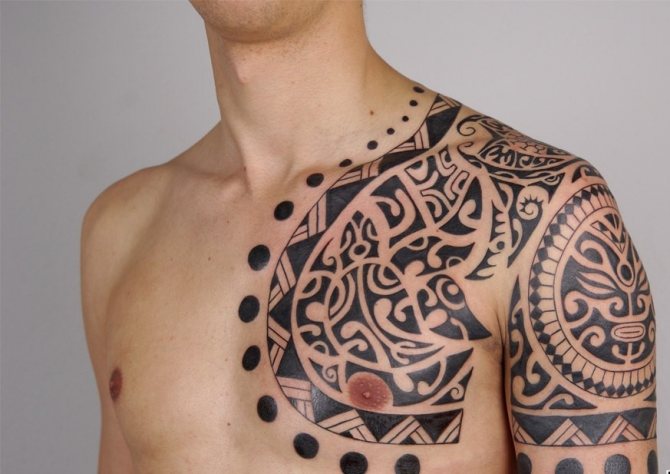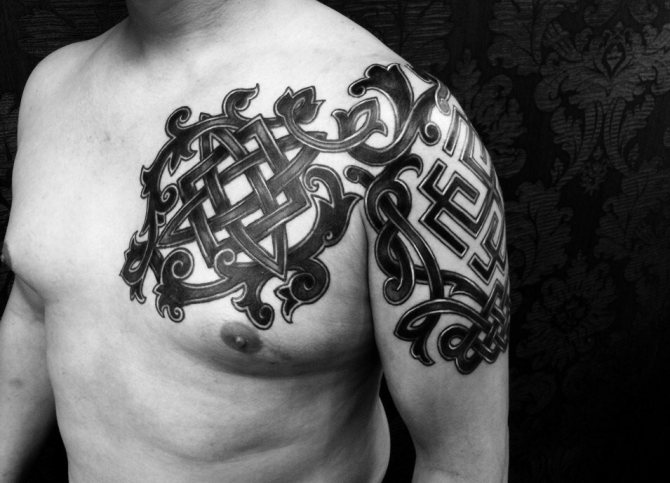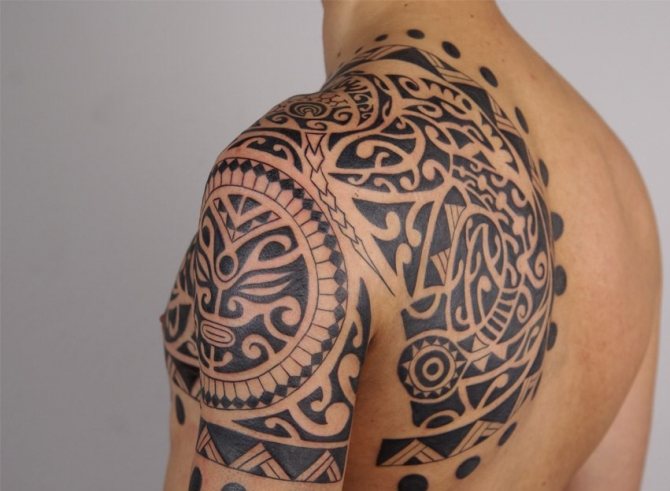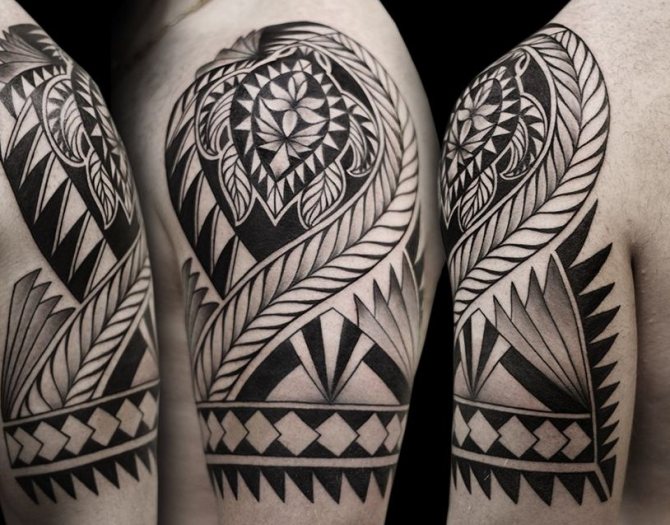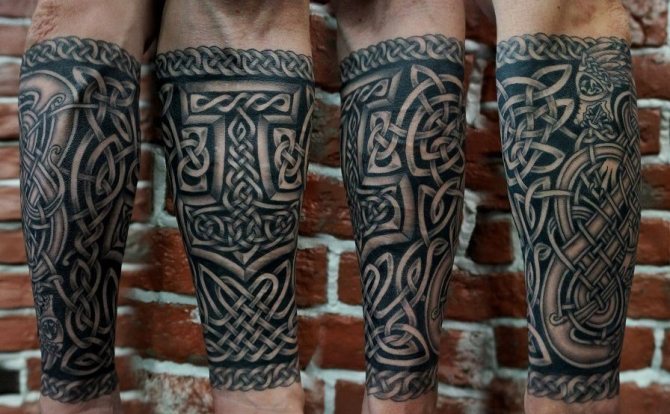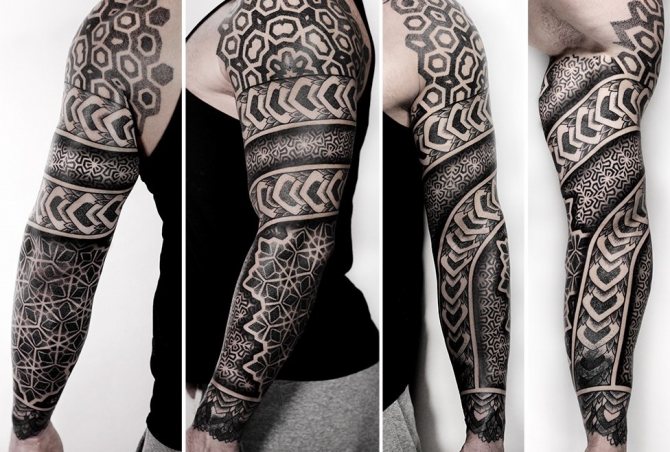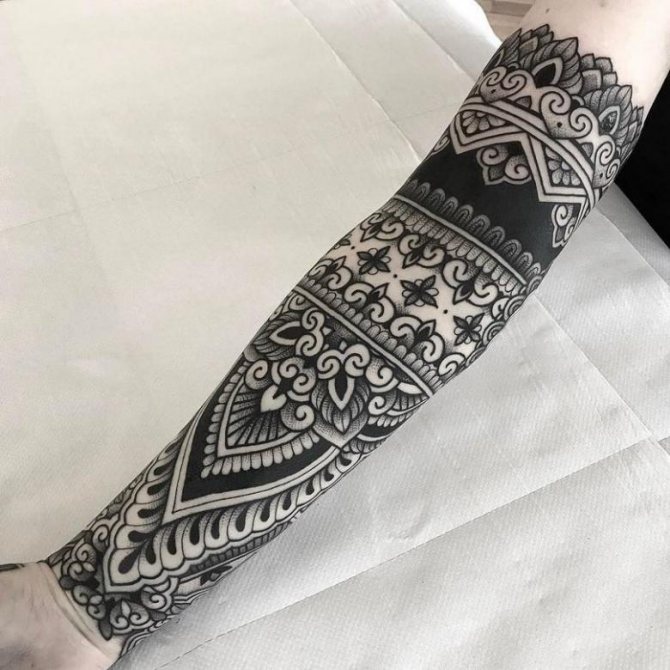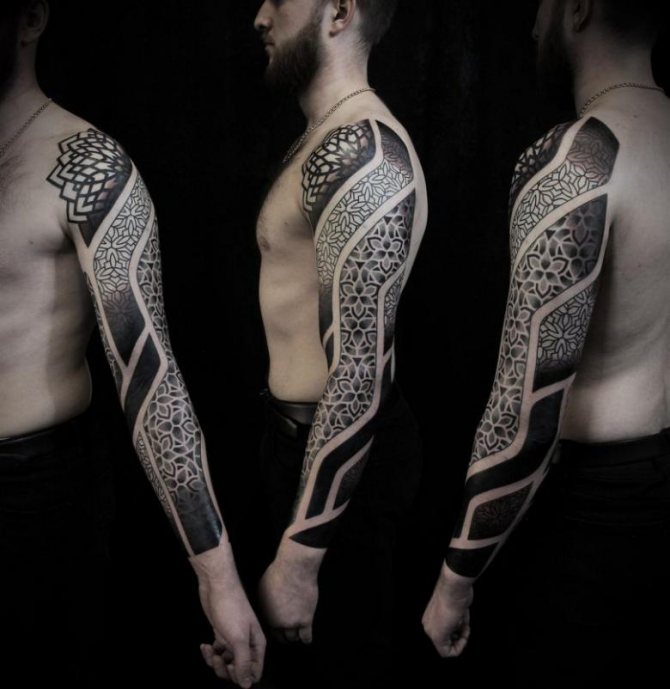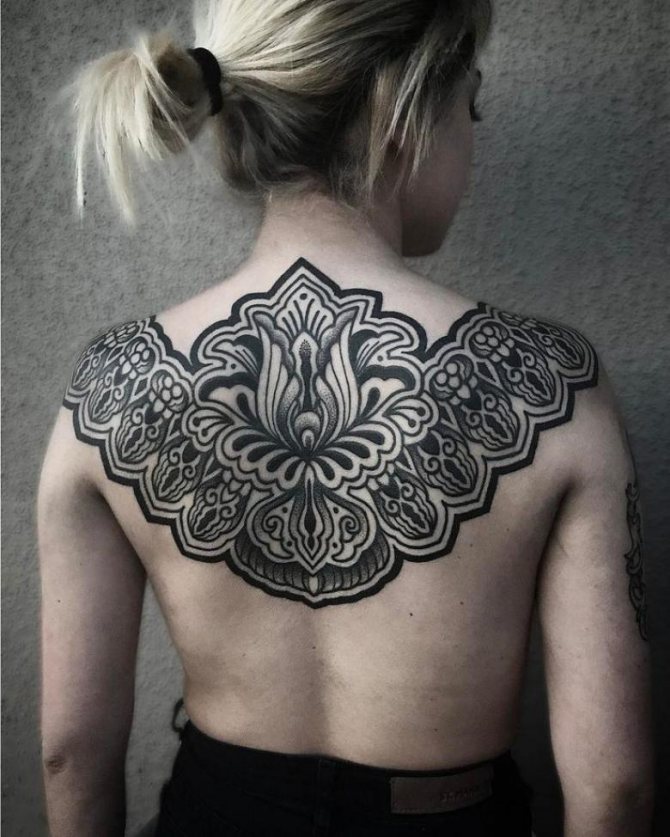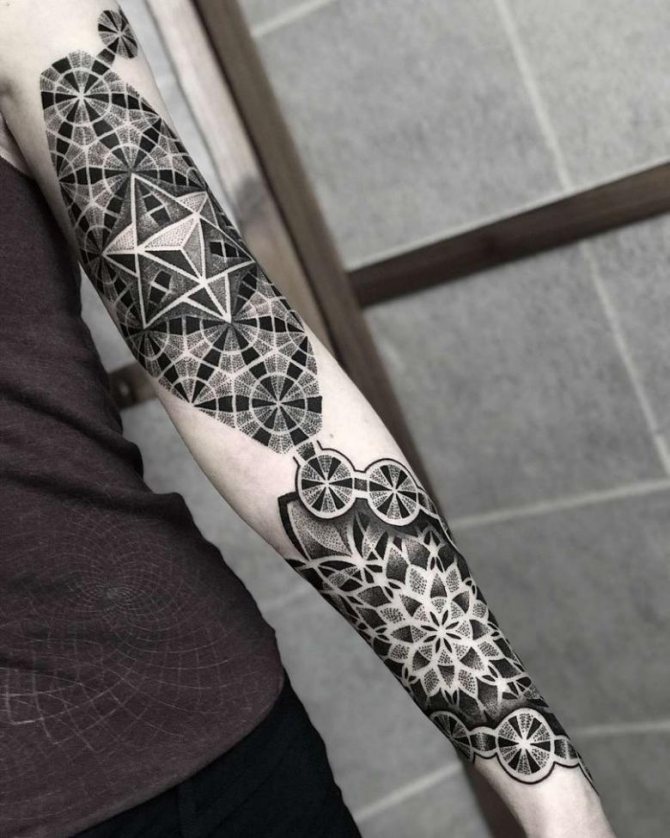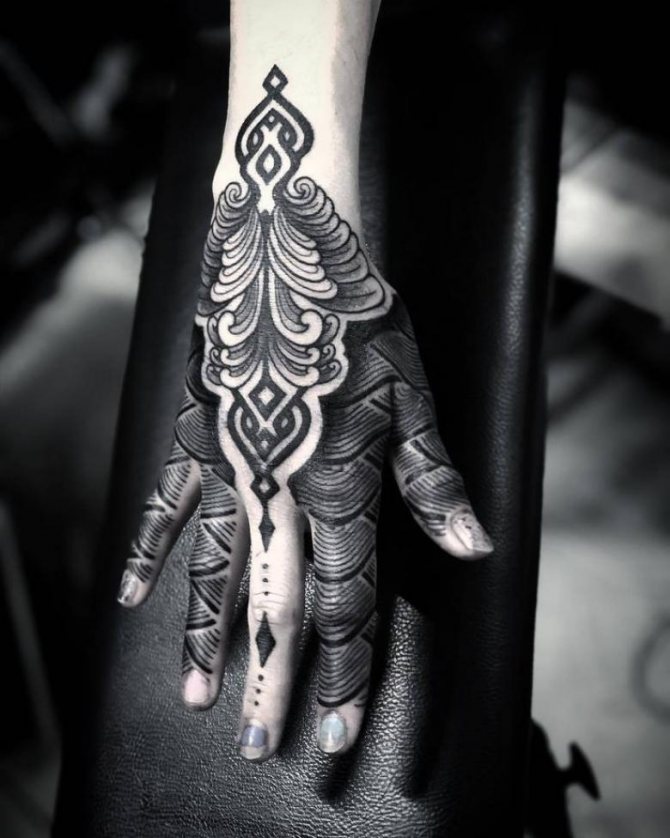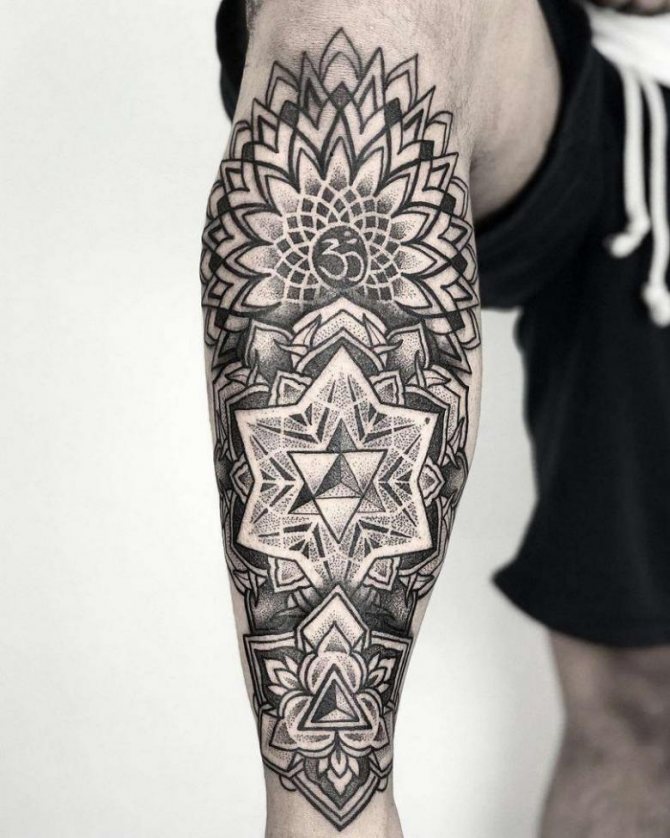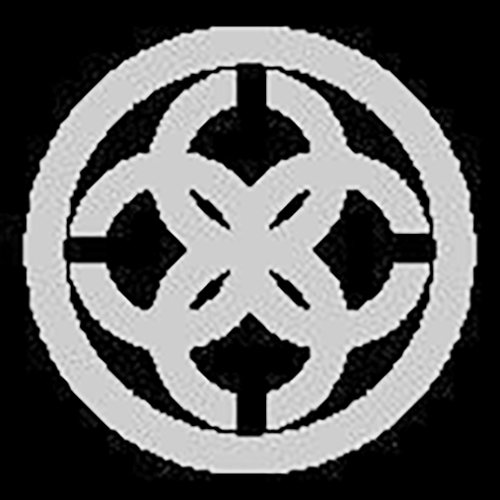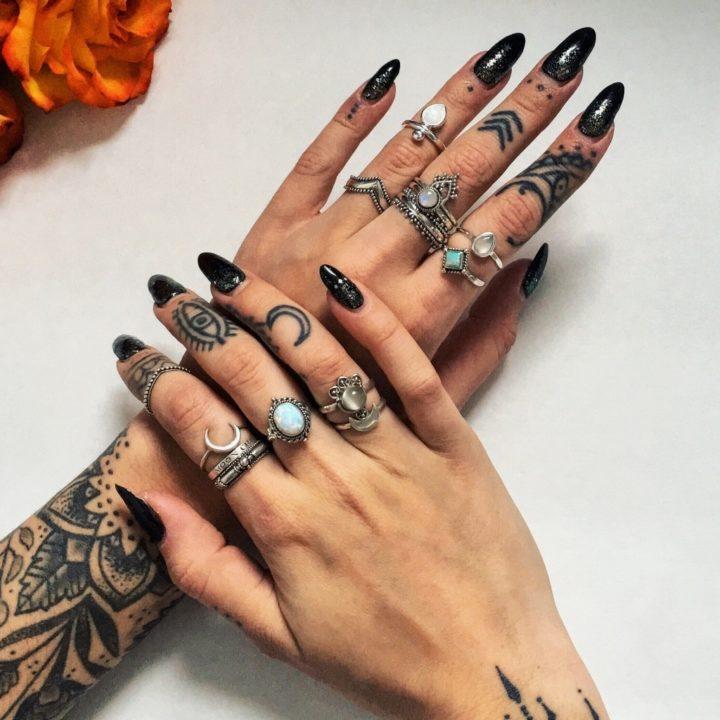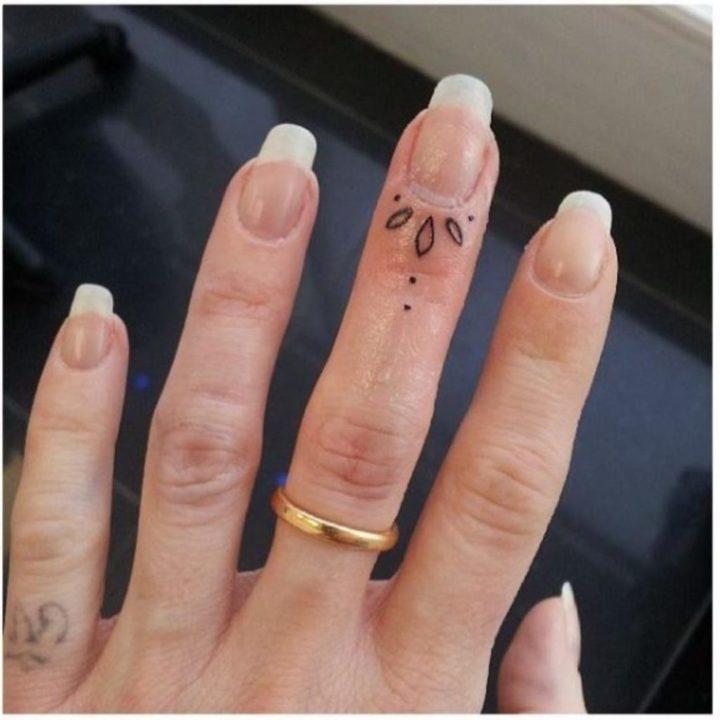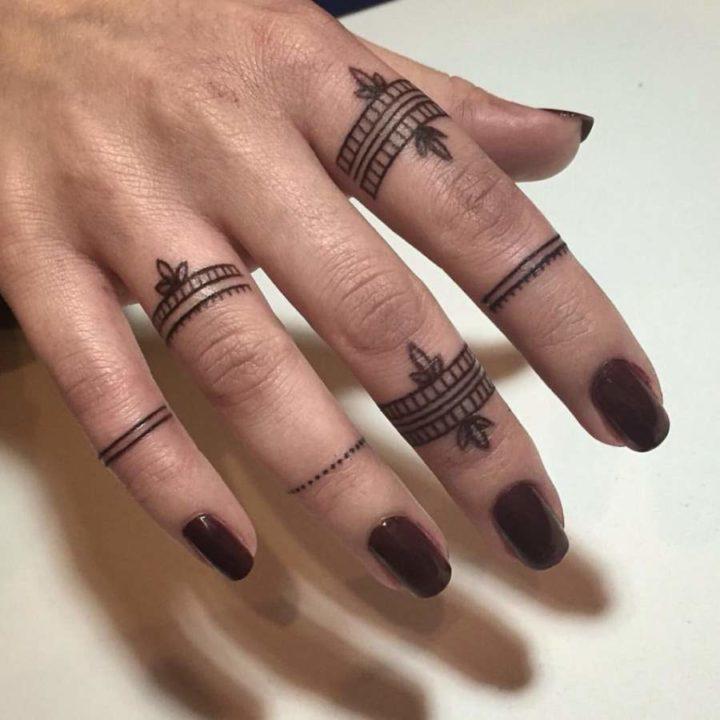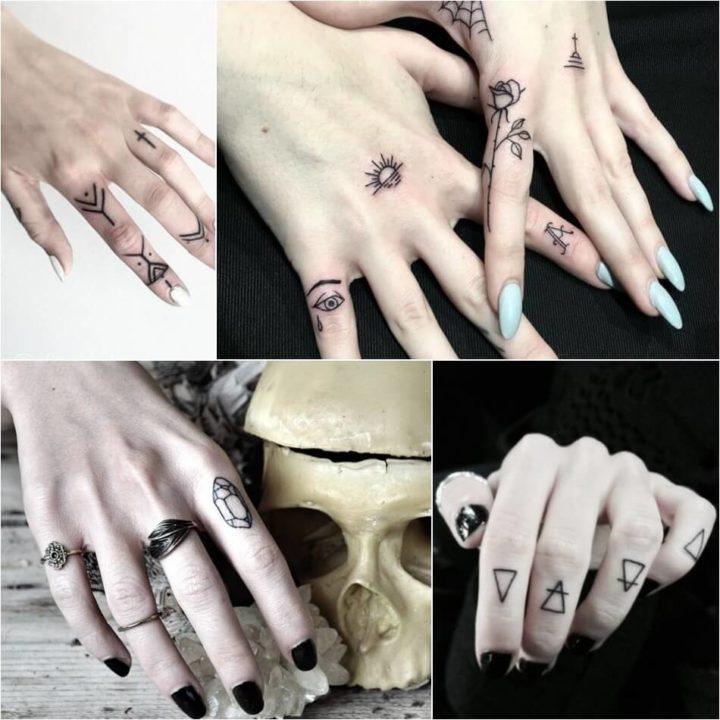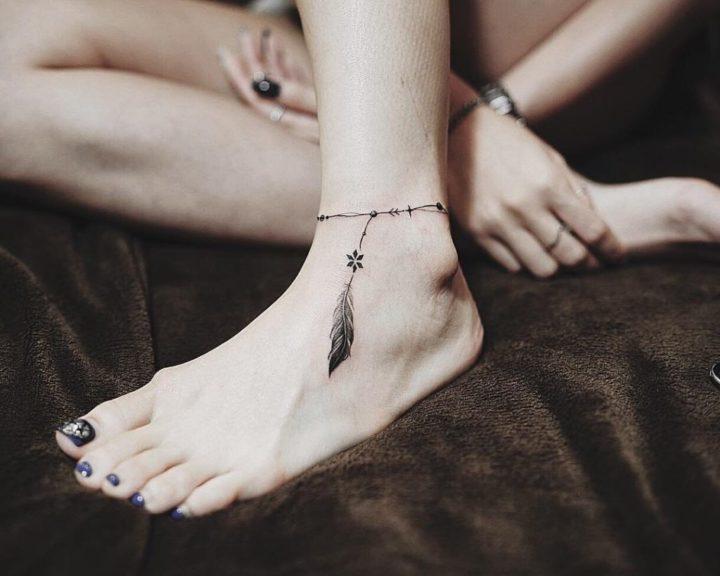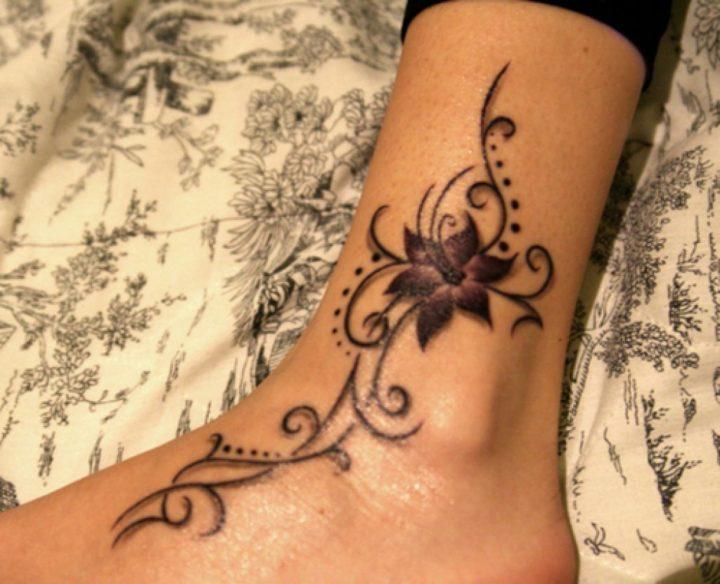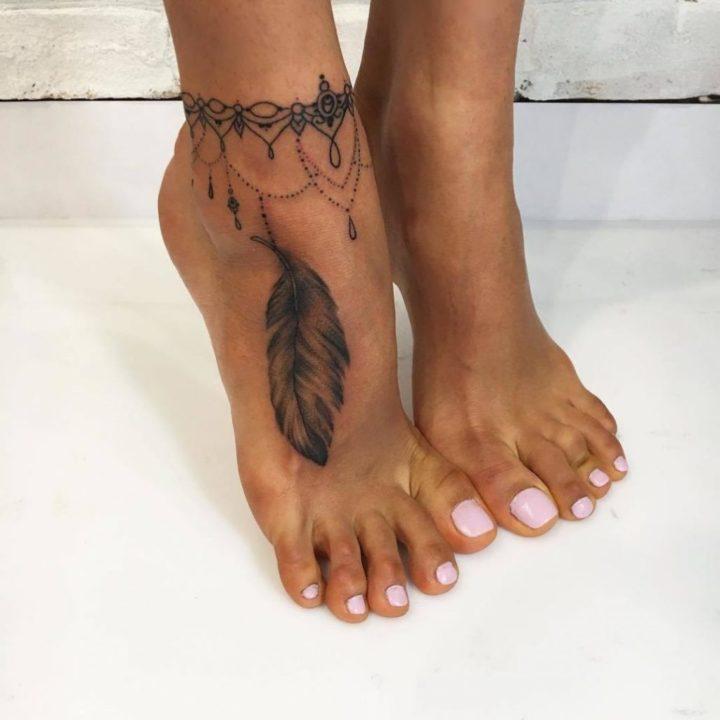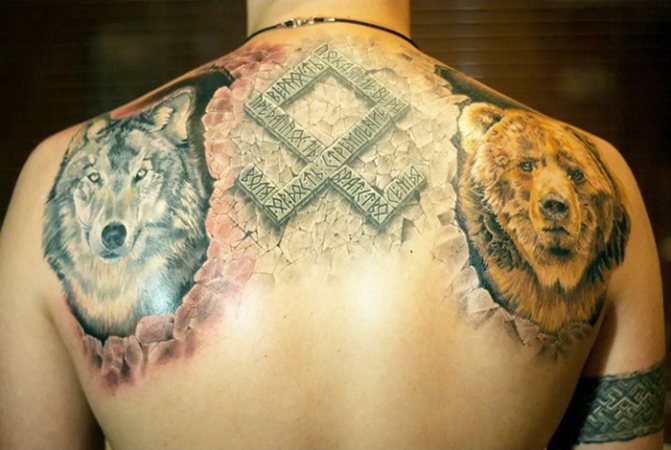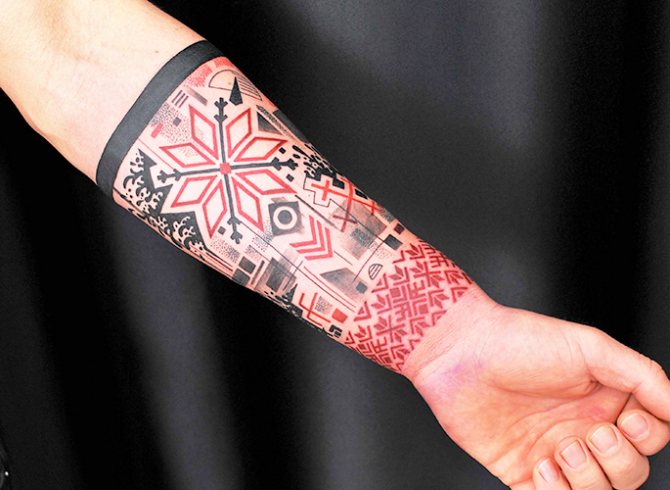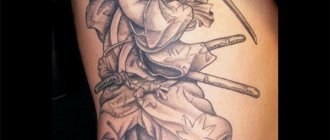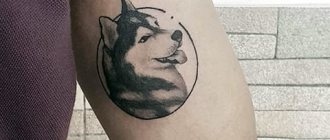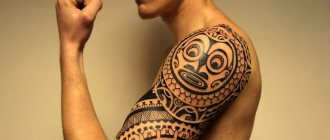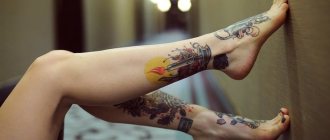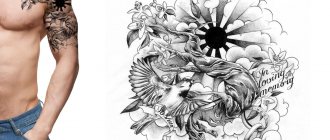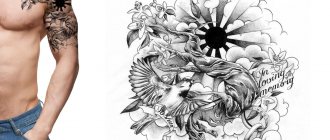Ornamental - one of the styles in the art of tattooing, which is a personal drawings that mimic woodcarving. In most cases, tattoos made in this style are not simple pictures, but patterns with a huge hidden meaning and exact meaning. Patterns are capable of hiding a person's life goals and priorities, traits and features of his character.
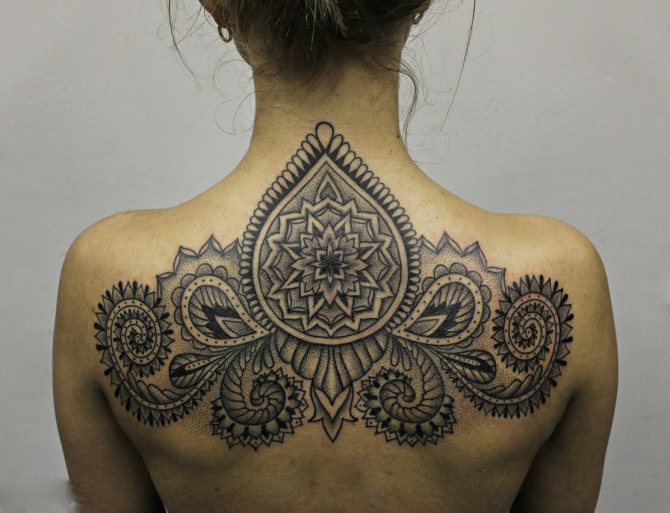
Most choose a tattoo ornament that creates an image of a personal totem, such as a particular animal. Tattoo ornament first appeared on islands located in the Pacific Ocean, as a type of body painting. In ancient times, a tattoo did not serve as a simple decoration, but had a ritual function and certain information. In the past, body art was an obligatory attribute of priests and shamans; moreover, only priests could put a tattoo on another person's body, demonstrating his high social status. Also body art was applied to the skin of children passing into adulthood.
If you look at the sketches and photographs of the finished work, you can see that this style is quite difficult to perform, because it requires a lot of time. The point is that the intricate patterns must have the utmost precision, and their appearance must attract others with its beauty and originality. When choosing a place often give preference to the arms, shoulders and legs, in more rare cases - the chest (for men) or the abdomen (female version).
Origin of Slavic tattoos
Slavic tattoo ornaments and patterns were never applied to the body for beauty. The Slavs had certain images that only men or women were allowed to wear, and there were images specifically designed for young children. The ancient Slavs firmly believed that any image on the human body could change one's destiny, give strength in battle, heal from diseases, help in conception, protect from spoilage and evil eye or improve one's social status.
Therefore, tattoos were treated very carefully, only wise men had the right to inflict them. Most often, the process of applying the image to the body was accompanied by certain rituals to enhance the impact of the tattoo on the person.
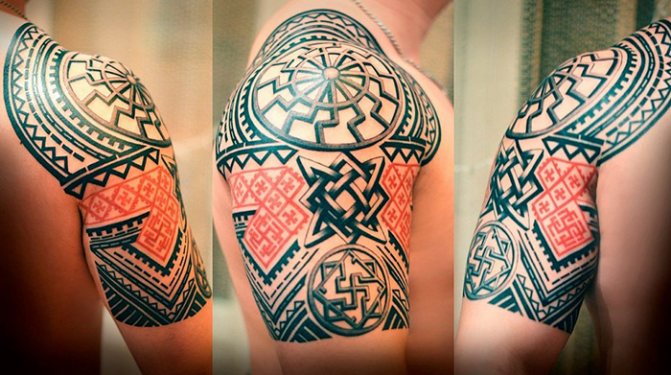

With the advent of Christianity in Russia, Slavic symbols as remnants of pagan worship were banned. Over time, the sacred meanings of Slavic tattoos have been forgotten and therefore, nowadays, it is difficult to find the exact image of Old Slavic symbols. Most often stylized images with characteristic Slavic motifs and colors are used, most often used in ancient Russian embroidery.
Sleeves of celebrities
The most striking examples are David Beckham, Dwayne Johnson and Adam Levine.
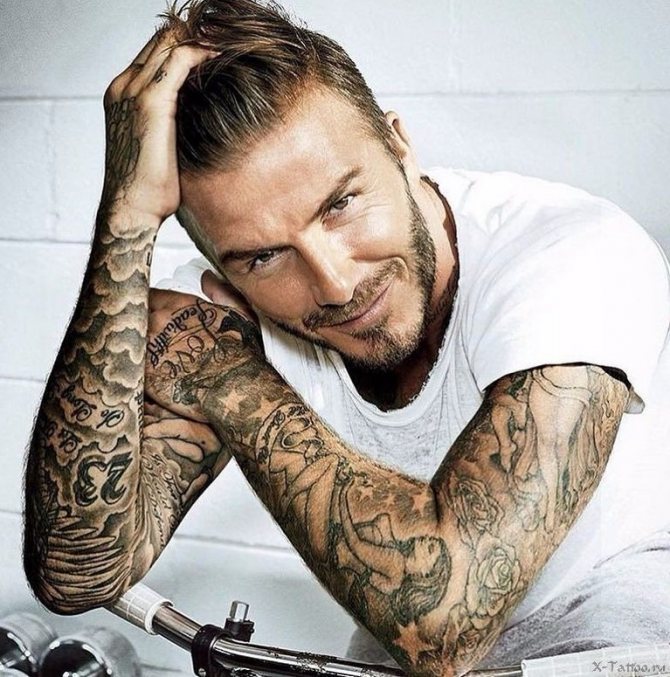

David Beckham
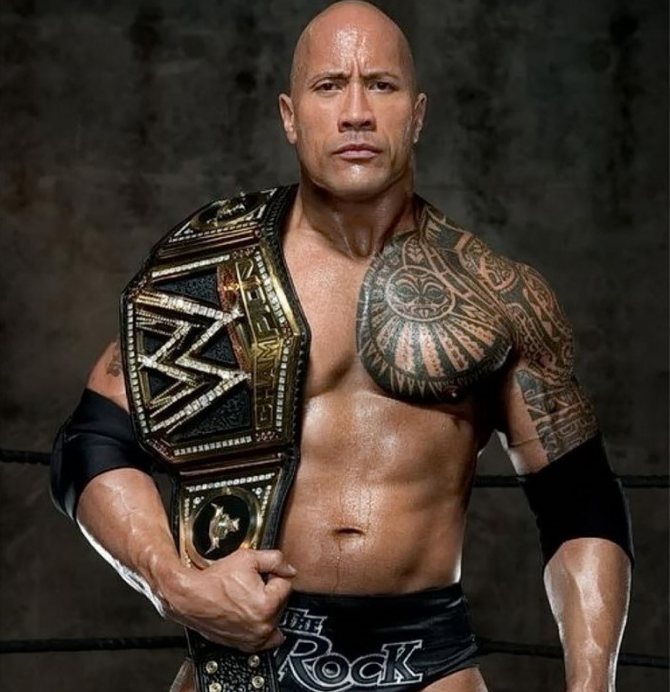

Dwayne Johnson
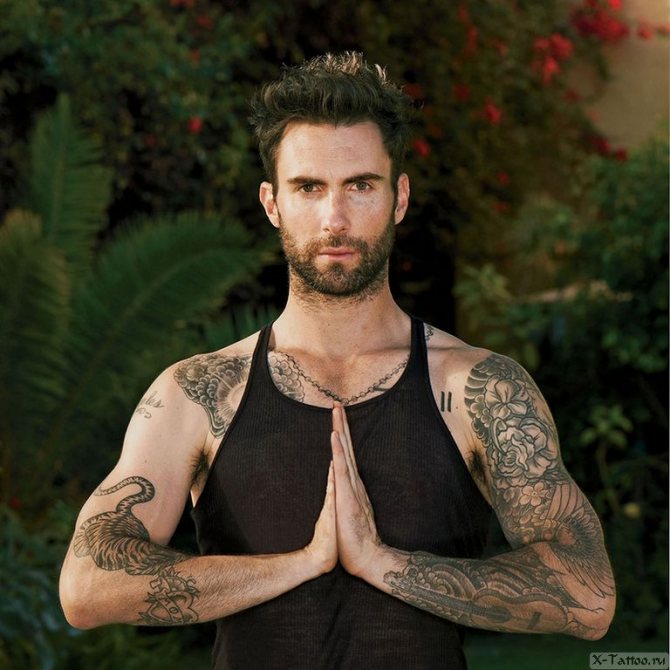

Adam Levine.
In fact, there aren't that many world-famous people with sleeve tattoos. For what reason - it is difficult to say.
But this does not mean that there are no such stars at all.
Among the Russian celebrities: Yura Muzychenko (Thomas), Timati, Yegor Krid.
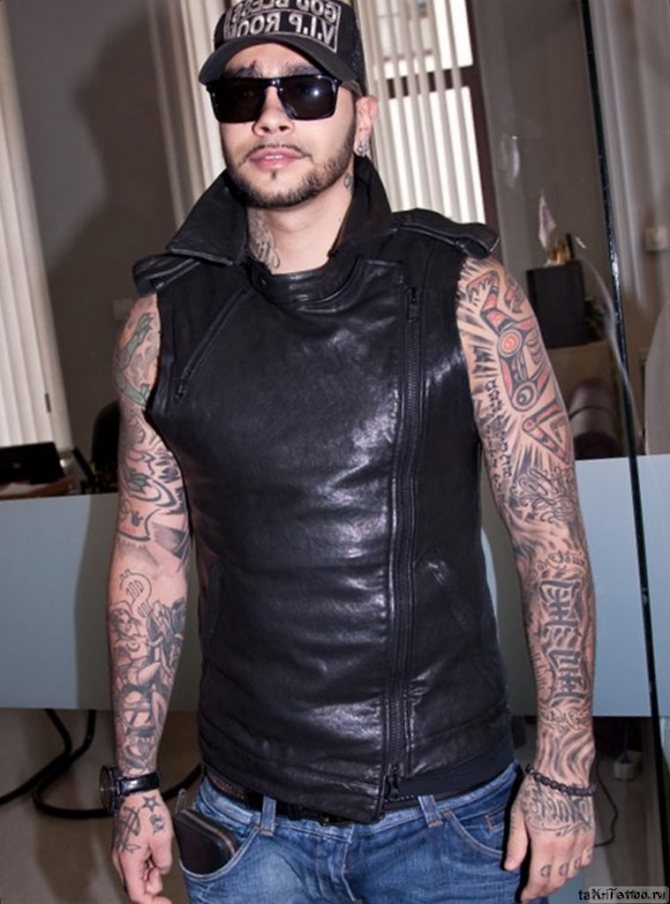

Timati
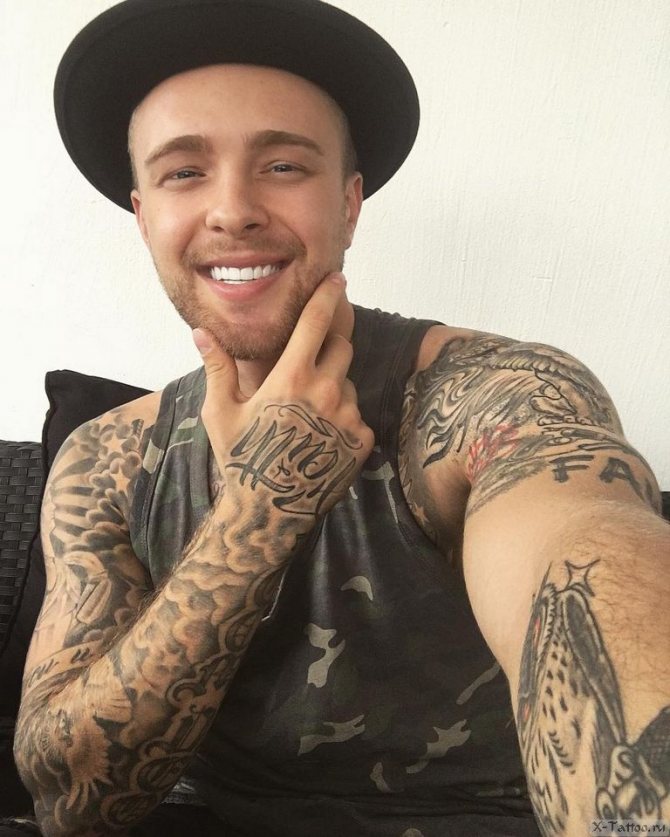

Yegor Creed
Features
Slavic images of ancient gods, rune alphabet, patterns and ornaments have clear lines of application, harmony and proportionality of the figure, the presence of additional volume and shadows. When choosing a tattoo on the ancient Russian theme it is important to find a professional tattoo master who can take into account all the nuances of the Slavic style.
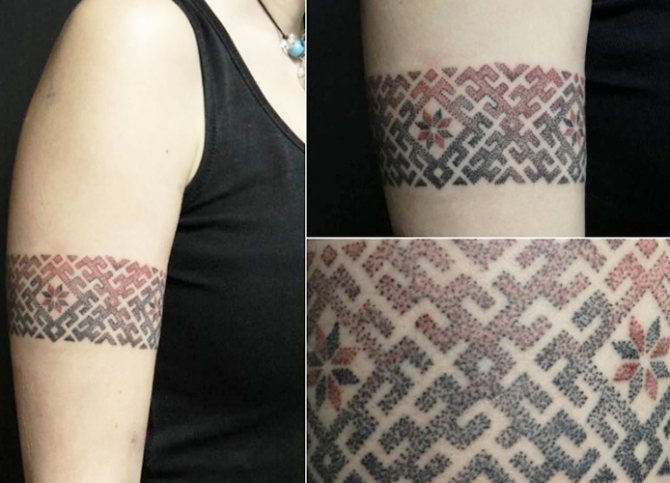

It is equally important to know the meaning of the applied symbols, as the Slavic runes are difficult to apply and it is very easy to make a mistake that will completely change the intended meaning of the figure.
What to choose: color or b/w.
Men more often choose black and white tattoos. The main subject lines are highlighted with a game of light and shadow. Such a variant is universal, will suit any shade of clothing.
If a man chooses a colored tattoo, he uses muted tones. So the tattoo is easier to combine with clothing.
If the guy prefers the Japanese style, he will have to use bright colors. The exception also becomes a style of thrash-polka, for which bright red is used.
Influence on a person's life
Slavic patterns and ornaments, according to tattoo lovers, still retain their unique abilities, and performed as a tattoo can have a positive impact on a person's destiny:
- contribute to the stabilization of the emotional background and even make changes in the worldview;
- protect against the effects of dark forces or negative energy of others;
- can have a beneficial effect on a person's health;
- help raise one's attractiveness and self-confidence;
- improve financial position and status in society.
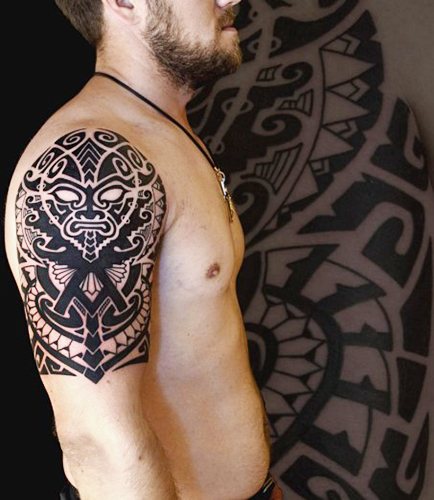

The most popular images that contribute to the changes in destiny are considered to be tattoos of totem animals, portraits and symbols of pagan gods - they can give a person the strength necessary to achieve their goals, protect against trouble and even endow the person with superpowers.
The Slavic amulets that can protect their owners and draw the blessing of the universe are very many, but the most common are:
| The Rod symbol is a universal amulet that helps to unite the mind, soul and body. For the ancient Slavs, the family was the basis of all beginnings, so this image appealed to the spirits of the family and guarded against all troubles. | |
| Light helps you to realize your dreams and achieve your goals. It was considered a symbol of the patronage of all Slavic people and embodied the light of life itself. | |
| Valkyrie - a symbol of wisdom, honor and justice. Most often, this amulet was worn by warriors to protect them from wounds in battle, and to tame their anger and fury at their enemies. The essence of the amulet is the ability to bring tranquility and put in order the thoughts of man. | |
| It was also used as a symbol of luck. It was believed that the person wearing it was lucky in all his affairs. To strengthen the amulet, in the center inscribed an additional image of runes or totem animal. | |
| The molvinets is a talisman designed to protect its bearer from human evil and spoilage. In addition, the symbol gave a person strength to cope with all difficulties of life. | |
| Wedding band - amulet, the image of which is traditionally applied to the bride and groom from different tribes, and symbolizes the successful union of the two families. |
Fingers
The most popular place for girls to apply a tattoo pattern is the fingers. Patterns can be applied in the form of rings, on the phalanges of the fingers, as well as on their inner side.
Styles and colors
Slavic patterns and ornaments for tattooing are usually performed in black and white, white and red and much less often in color. Tattoos with a clear graphic depiction of the main motif in black and the addition of red symbols are popular.
Traditionally, the first Slavic tattoos are considered to be ornaments and patterns affecting a person's strength in battle and the well-being of the family home. Patterns included images of birds, animals, plants. Such tattoos had colorful designs and served to attract the forces of nature.
With the advent of Christianity, images of flowers and crosses began to be added to the traditional style, intricately weaving them into the classic Slavic design.
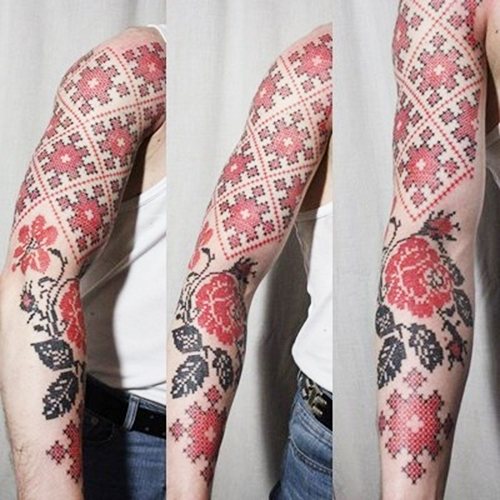

Slavic ornament is characterized by cyclicity and squareness of depicted symbols, reminiscent of the ancient Slavic embroidery in white and red colors.
The Slavic style also includes images of portraits of pagan gods, which gave their power to the bearer of the tattoo. In the modern world no one seeks to attract the favor of higher forces, but their colorful and colorful images attract their originality and expressiveness.
Most often were depicted gods - Perun, Dajbog, Stribog and Veles, symbolizing military strength and power. Old Slavic images also include symbols of wind, rain, thunder and lightning, as well as the four elements - water, air, fire and earth. These symbols were applied both in color and in black and white.
The most famous symbol is the Slavic Swastika, the symbol of the Sun.
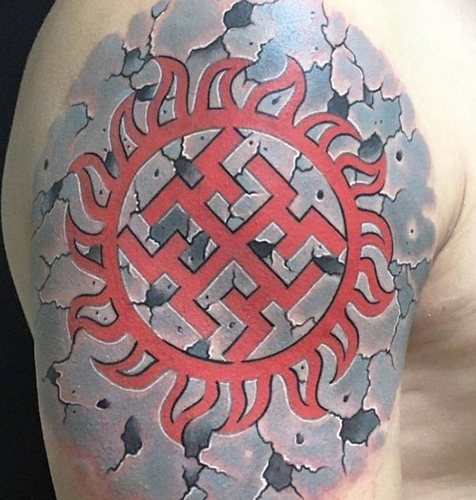

Slavic ornaments and patterns for tattooing often contain runic symbols
Runic signs of the Old Slavic alphabet were applied in black and white, with clear lines and shadows. Runes refer to the most mystical images, not without reason and now there are many stories about the influence of the runes on a person's destiny.
Not having anything in common with ancient Slavic culture, but firmly embedded in modern life as symbols of the original Russian, are images of fairytale and epic characters, as well as Gzhel and Palekh ornaments.
The ankle .
On the ankle you can make a beautiful pattern in the form of a bracelet. Also, a relevant idea is to apply the tattoo pattern on the outer side of the foot, which smoothly passes to the lower leg.
On what places are attracted patterns and ornaments of Slavic subjects
When applying the Slavic symbols on the body it is necessary to think beforehand about the place where tattoo will be applied. With the right placement tattoo can be not just an ornament, but a real averter and a source of strength. The most popular place to place the pattern on your shoulders, forearms and wrists. Larger images are applied to the chest and back.
Shoulder
Images designed to ward off evil, illness and magical influences were traditionally placed on the shoulder.
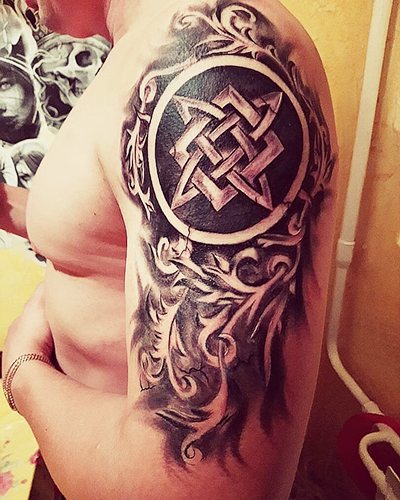

Ornaments and patterns consisting of geometric figures were depicted for protection.
Forearm
The forearm was a part of the body that was visible to others, so it bore images showing martial skills, number of victories or special abilities, social status or belonging to a prominent clan or tribe.


On the forearm there were large, colorful images of gods and their symbols, totem animals, plants and runic script.
Wrist
The ancient Slavs believed that the wrist was a special part of the body, directly connected with the soul and heart. This is where the runes, amulets and patterns symbolizing the divine origin were placed. The tattoos had a double meaning - to soften the heart of man and protect his soul from the curse.
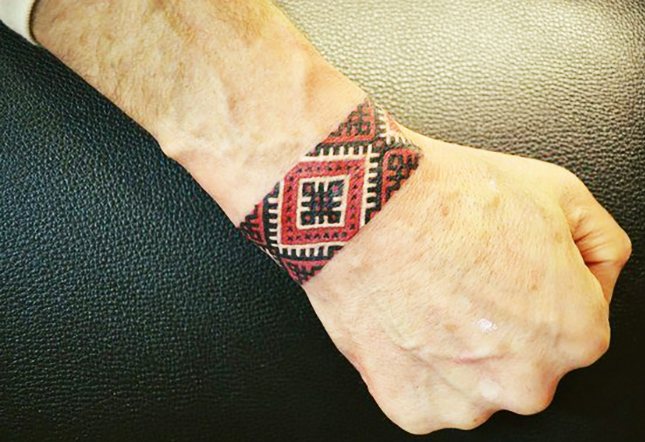

Images of divine symbols were placed on the back and chest, providing protection and prosperity for their owner. Often such images were hidden from view (only warriors boldly displayed their torsos).
Made of nylon
Since you have read to the end of the article, we can conclude that you are seriously thinking about your own tattoo sleeve. But for whatever reason, you still haven't nailed it. Maybe you doubt whether the sleeve will suit you, whether it will be too daring, etc.
To make it easier to decide, we advise you to buy nylon tattoo sleeves.


They are simply put on your arm and look like tattoos. So you can try on the image on yourself, look at the reaction of other people and finally decide what kind of male tattoo sleeve you need.
Sketches of Slavic patterns and ornaments for men
Slavic patterns and ornaments for tattooing men, first of all, endowed its bearer with physical strength, boundless power, wisdom and good health.
Less often, the patterns and symbols were applied to develop a gift or to protect against magical influences:
- Bear Bear was depicted as a symbol of masculinity and endowed the man with power and authority. To carry the image of a bear could only the eldest members of the family. Bear worshiped by the spirit of the forest under the patronage of the god Veles. For the modern man tattoo with a bear may symbolize the strength of spirit and heroic health.
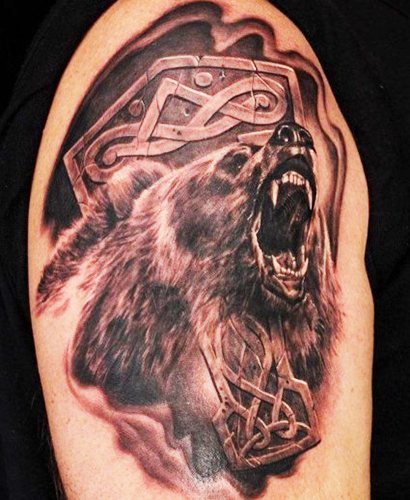

- Wolf . With Slavs revered as a symbol of loyalty and independence. Single warriors wore a picture of a wolf on his forearm. And the open-mouth wolf symbolized righteous anger and lust for revenge, and with the closed - the wisdom and peace of mind. Currently, the wolf is a symbol of strength and loyalty.
- The tree in Slavic mythology symbolizes wisdom and human experience. Most often, the tree with a thick trunk was depicted on the backs of already elderly warriors or magi. Another meaning of the tattoo is a happy family - a tree with many branches and leaves was depicted, symbolizing a long and happy family life.
- Fern - A very strong symbol of Slavic themes, protecting from the dark forces. As it was considered since ancient times that a man is responsible for the well-being of his family, the fern flower was placed on the shoulder of the head of the family as a sign of wisdom and intuition, allowing him to make the right decisions and avoid the intricacies of fate.
- Veles - Old Slavic god of fertility. Patron of all animals and plants. It was believed that the man who made a tattoo of Veles, able to easily develop their abilities in various fields of science and receive recognition for their work. The figure of Veles was traditionally worn on the shoulder, close to the head.
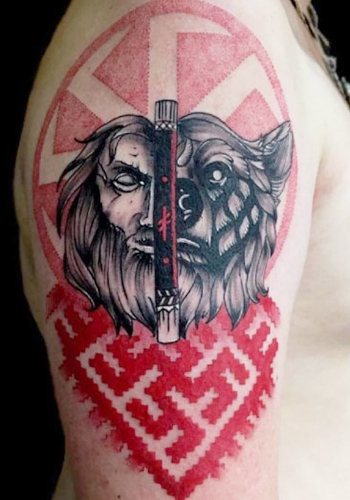

- Perun - A pagan god of thunder and lightning, under whose patronage were all warriors and persons endowed with power. It is a symbol of the power of the gods of the world, and a symbol of the power of the gods of the world. Perun is one of the main gods of Slavic mythology, so he was treated with special respect and tattooed on his entire back, depicting the god together with his axe.
- Ud - This was the symbol of the Slavic Age of Thawan and the symbol of the Black Sword. Such a symbol can be worn on the wrist or forearm. The image gives its bearer masculine charm and increased sexual energy.
- Alatyr . - Rune, symbolizing a new beginning, a renewal. The carrier of this Slavic symbol can get rid of addiction and start a clean slate.
- Svarog Square. - The most ancient amulet of Slavic craftsmen. It helps the representatives of the strong sex when working with metal, contributes to the manifestation of ingenuity and energy of creation. It is believed that this symbol can give a person the superpowers of a fortune teller, but only if the person will be worthy of such a gift.
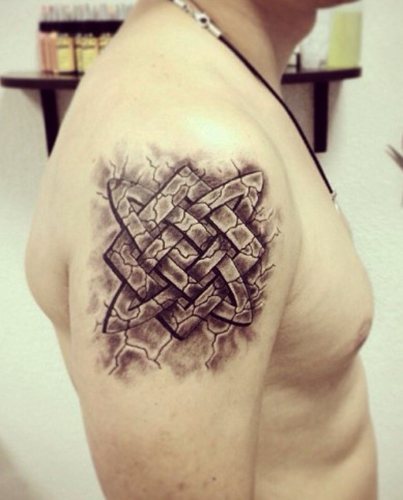

- Caroler - A symbol used by men to fulfill their cherished desires. According to the old Slavic custom, such a symbol was applied to the back of the head.
Beautiful patterned and ornamental tattoos of Slavs for girls
Slavic patterns and ornaments for tattoos for girls were graceful and subtle, they were distinguished by the smoothness of lines and intricacy of execution. All of them reinforced the feminine and protected the woman - the guardian of the family home.
Very often female animals (usually a doe or a moose) were depicted in tattoos, combined with various ornaments responsible for the family's well-being.
Until our days have survived patterns of embroidery with these animals. There was a belief that in the image of the animal was inhabited Dazhdbog - the sun god, giving prosperity, warmth and fertility.
No less common were tattoos with runes and symbols of Slavic goddesses:
- Makosh - A pagan goddess who holds the threads of human destiny in her hands. She patronizes older women, protects the family home and endows women with amazing intuition that allows them to anticipate misfortune. In the modern world, a tattoo with the symbol of the goddess of earth will help women to discover their inner strength and to realize themselves as a wife and mother.
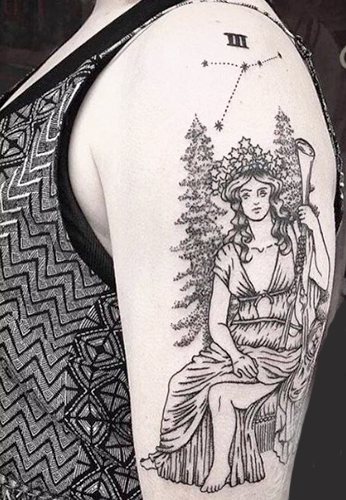

- Bereginya - Old Slavic goddess, embodying the feminine beginning. Symbolism had a great sacred meaning: it was believed that only girls who lived by the laws of their ancestors, deserved her blessing and patronage. In today's world, the image of the goddess symbol can help a girl develop her feminine charm and become a true guardian of family traditions.
- Lelia - runic symbol of spiritual love. It is connected with feminine energy and the energy of water, promoting renewal and creation. It was believed that the bearer of this image had a heightened intuition. For modern girls, this rune can bring spiritual harmony and enlightenment.
- Cross of the Lada of the Mother of God (or Ladinets) - is the strongest amulet for women. The ancient Slavs wore an amulet or applied such a symbol to their daughters as early as three years old, believing that it would help develop feminine qualities: beauty, humility, wisdom and the ability to work as a woman. The symbol of the goddess Lada in the modern world will be the amulet of love and family happiness.
- Star of Lada - Slavic symbol, the essence of which is to protect a woman's health from painful childbirth and difficult pregnancy. Sick girls from an early age tattooed on a part of the body hidden from public view. It is believed that this symbol also helps to correct a woman's quarrelsome character.
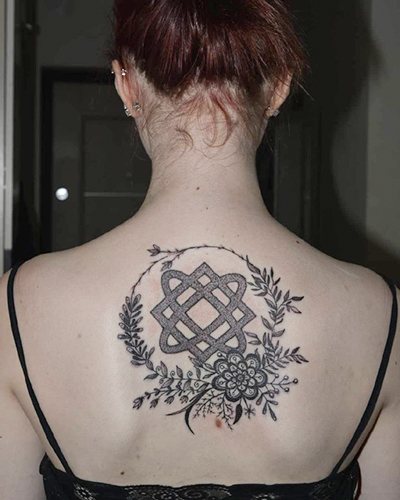

- The Moonflower - A symbolic image that protects its bearer from the effects of dark magic and misfortune intended by fate. Usually such a tattoo was applied only to young girls with weak energy, to protect their young souls from evil spells.
- The Eye of Horus - The eye of the goddess, the eye of the goddess of all things in heaven and on earth, is the wandering eye of the goddess of all things in heaven, and the wandering eye of the goddess of all things in heaven. In addition, the symbol protected its wearer from negative magical influences.
Slavic patterns and ornaments have many variations for creating a unique and inimitable tattoo, but you must remember that any Slavic image has a sacred meaning that goes back to antiquity. In order not to be disappointed and to avoid possible unpleasant consequences of the wrong pattern, it is worth before applying a tattoo to carefully study all available material on the meaning of the symbol you like.
Author: Julia Loboda
Tips for tattooing
The obvious advantage of mesmerizing Ornamental patterns can be called the possibility of bold experiments with shape and fragments. However, the result of the tattooist's work will not bring joy without following the rules of preparation.
What you need to do:
- Choose a qualified master, who uses sterile tools, disposable needles and gloves, fresh pigments;
- Three days before a visit to the salon to refuse alcoholic beverages, because their influence will have a negative impact on the brightness of the tattoo and skin healing;
- before going to the tattoo shop do not forget about personal hygiene, a shower will clear the skin, unwanted vegetation must also be removed;
- In the case of the choice of large sketches on the most painful places, before the session is worth a snack to lower the pain threshold.


Among the many compositions for the Ornamental tattoo you can find a common feature - the presence of a central element, which is associated with the energy of harmony, as well as order. In addition to shades of black, the subjects for girls are often complemented by red. This is an ancient symbolism of fire, protecting the human soul from the attack of evil forces, burning bad thoughts.
